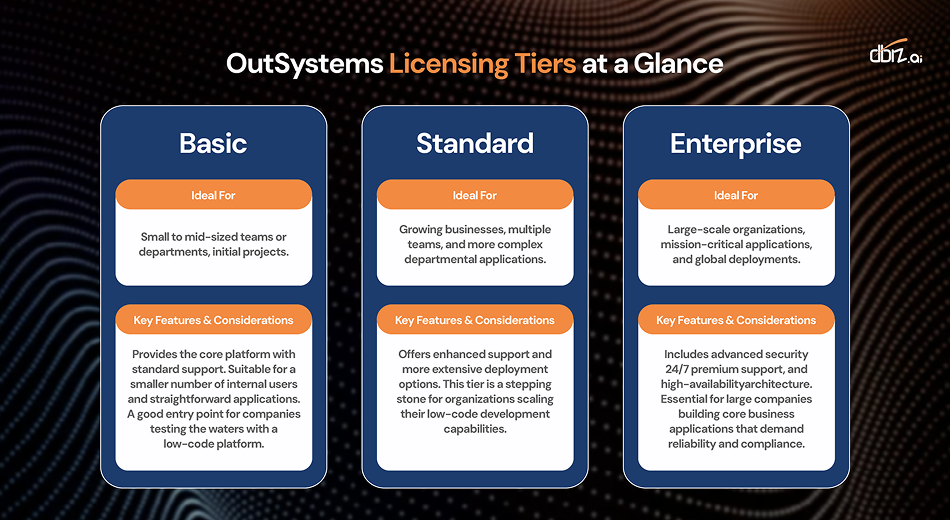Table of Contents
Introduction to Understanding OutSystems Licensing: Models, Pricing, and How to Maximize Value
Many decision-makers find OutSystems licensing complex, but it doesn't have to be. At DBiz, we've helped dozens of companies optimize their investment by focusing on what truly matters: a licensing model designed to grow with your success. The biggest mistake is overthinking it.
OutSystems built their pricing to reward growth, not punish it. This is a significant departure from most traditional enterprise software. Once you grasp this core concept, navigating the specifics of OutSystems pricing becomes straightforward. This guide, from our team of OutSystems experts at DBiz, will help you understand the key components and equip you to maximize your investment from day one.
Common Challenges and Licensing Models
The first call we usually get is from a frustrated CFO trying to budget for OutSystems like it's a stack of Microsoft Office licenses. This is the wrong approach entirely. OutSystems licensing is based on usage and complexity, not on a per-developer or per-install basis.
The Developer Cost Myth
"How much per developer?" This is the most common question and the most misleading. OutSystems doesn't charge for developers at all. Your entire development team can work on the platform without impacting your licensing costs. This breaks the mental model of enterprise software pricing for many people, especially those used to legacy low-code platforms.
Application Objects Anxiety
Every technical evaluation gets stuck here. Your developers understand entities, screens, APIs, and workflows. Business leaders hear "Application Objects" and panic about a unit of complexity they can’t control.
An Application Object is the core metric for measuring application complexity in OutSystems. Think of it as a building block. Small applications may use 50-100 objects, while large enterprise systems might use 500-700. The key to efficiency is reusability. For example, you can build a reusable component, like a customer authentication module, and use it across multiple applications without consuming additional Application Objects. This is where smart architecture pays off. At DBiz, we help clients design for reusability, leading to significant licensing savings.
OutSystems Licensing Tiers at a Glance
OutSystems offers different editions, or tiers, to fit a wide range of organizational needs. While the core pricing metrics of Application Objects and users remain constant, the tiers provide different levels of functionality, support, and scalability. Choosing the right tier is a strategic decision that impacts your entire low-code development lifecycle.

Technologies and Deployment Flexibility
OutSystems offers two primary technological architectures: OutSystems 11 and OutSystems Developer Cloud (ODC). While they have the same core licensing structure based on users and Application Objects, they offer different deployment advantages.
- OutSystems 11 (O11): The Traditional Choice. This architecture is robust and flexible. It can be hosted anywhere from the OutSystems Cloud, on a private AWS setup, or even on-premises. Licensing costs remain consistent regardless of your hosting choice.
- OutSystems Developer Cloud (ODC): The Modern, Cloud-Native Architecture. ODC is designed for the modern enterprise, leveraging containerized microservices and Kubernetes. This enables greater agility and automated DevOps practices, allowing for faster and more efficient deployment.
Both platforms measure complexity in the same way, counting database entities, user screens, APIs, and business workflows as Application Objects. DBiz has helped clients using both architectures, in some cases optimizing applications from over 800 Objects down to 400 without losing functionality, and often improving performance.
Use Cases That Actually Matter
The Financial Services Reality Check
A financial services client came to us with a complex customer portal and 10,000 external users. It seemed expensive, and their internal team was struggling to keep costs down. What we discovered was a classic case of redundant development. Multiple teams had built similar functionalities. For instance, a customer lookup existed in four different applications, and reporting logic was duplicated everywhere. This siloed approach was driving up licensing costs unnecessarily.
What DBiz did: We consolidated shared services, made database entities reusable, and standardized UI components. We also centralized the reporting engine.
- Started with: 800 Application Objects across redundant systems
- Ended with: 480 Application Objects with better performance
- Result: A 30% ongoing savings through smart user management and efficient architecture.
Retail Seasonality Strategy
A retail client faced a unique challenge: their internal workforce would swing from 200 to 800 employees during peak seasons, and their customer-facing applications needed to handle extreme traffic. Licensing for maximum capacity year-round would have been costly and inefficient.
What DBiz did: We structured their license to account for a core staff with a flexible overflow capacity for seasonal workers. We implemented a dynamic user management system that could scale automatically. This simple change led to a 25% annual saving and greater flexibility.
Conclusion
OutSystems licensing rewards smart planning and efficient architecture. Companies that understand these principles typically achieve 20-40% better licensing efficiency than those who treat it like traditional enterprise software.
The low-code market continues to evolve, but the fundamental principle of OutSystems remains constant: reward reusability, enable scaling, and support business growth without penalty.
At DBiz, we’ve guided dozens of organizations through these decisions. The pattern is always the same: companies that invest the time to understand OutSystems pricing before implementation avoid expensive restructuring later and build applications that scale efficiently.
Your next step should be to map your specific requirements like your user base, application complexity, and growth trajectory, against OutSystems’ licensing parameters. Most importantly, design your architecture with licensing efficiency built in from day one.
Come optimize your low-code development and OutSystems investment with DBiz. We bring proven methodologies and deep platform expertise to help you build applications that deliver maximum value within optimal licensing parameters.


